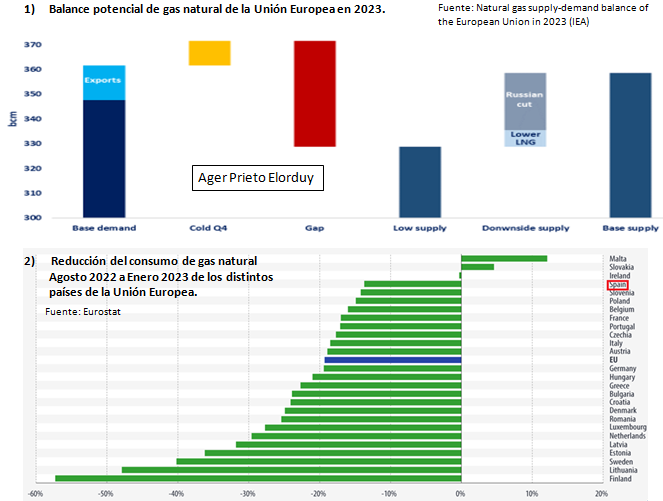71) Análisis del gas natural en Europa: 2º invierno tras la guerra de Ucrania (año 2023/2024)
Como vimos en la previa publicación, el balance del gas natural es dinámico por naturaleza. Según el reporte de IEA “Natural gas supply-demand balance of the European Union in 2023”, se espera que la demanda de gas natural en la Unión Europea disminuya a 350 bcm en 2023, cerca de un 3% (10 bcm) en comparación con 2022. (Por refrescar las unidades 1 bcm = Mil millones de m³).
Se puede afirmar que el 1º invierno tras la guerra de Ucrania ha sido atípico cuanto menos, coincidiendo en la misma ventana temporal; un menor apetito China por el gas natural debido a la política 0 covid y un invierno más suave que el promedio. Pero, ¿cuál puede ser el desenlace si 2º invierno las condiciones no son tan favorables para los europeos?
En el siguiente grafico podéis apreciar exactamente dicho escenario, donde Rusia corta el suministro (-25 bcm), invierno más frío (requerimiento extra de 10 bcm) y actividad industrial del sudeste asiático acorde al musculo que posee. El resultado es evidente, surge un desajuste de 45 bcm. Para quien se lo pregunte, el consumo anual de un país como España es de 32 bcm (339 TWh), para que calibréis es el quinto país del ranking europeo de mayores consumidores tras Alemania, Italia, Francia y Países Bajos.
A todo esto debemos sumarle otro hándicap, ya que, durante 2022 se ha contado con suministro ruso que ha permitido llenar los depósitos de almacenamiento de los miembros de la UE. Sin embargo, dependerá del transcurso de la guerra si en 2023 se podrá contar con ello.
A 22 de marzo de 2023, los depósitos de la UE albergan 59 bcm, es decir, al 55% de su capacidad.
Para contrarrestar todo ello, la UE ha optado por diferentes actuaciones:
1) Fortalecer la diplomacia energética para aumentar el flujo de entrada del GNL con países como EE.UU., Argelia, Azerbaiyán y Noruega. Solo Estados Unidos representará más de la mitad del incremento del suministro, respaldado por el aumento de la terminal de GNL de Calcasieu Pass y el regreso de Freeport GNL.
2) Incrementar un 25% (aumento de capacidad de 40bcm respecto al 2021) las nuevas unidades flotantes de almacenamiento y regasificación (FSRU) en Países Bajos, Finlandia y Alemania y la expansión de terminales de regasificación.
3) Tratar de reducir intencionadamente el consumo de gas natural, adoptando mejoras de la eficiencia energética, la expansión continua de la generación de energía renovable, despliegue de bombas de calor y cambios de comportamiento.
Según los datos de Eurostat, durante el periodo agosto 2022 a enero 2023 el conjunto de la Unión Europea ha reducido un 19,3% el consumo del gas natural. En el caso de España solamente 13,7%, siendo Finlandia el que más ha recortado el consumo, un total del 57,3%.
Veremos lo que nos depara el segundo invierno tras el inicio de la guerra de Ucrania.
71) Analysis of natural gas in Europe: 2nd winter after the war in Ukraine (year 2023/2024)
As we saw in the previous post, the natural gas balance sheet is dynamic in nature. According to the IEA report "Natural gas supply-demand balance of the European Union in 2023", the demand for natural gas in the European Union is expected to decrease to 350 bcm in 2023, about 3% (10 bcm) compared to with 2022. (To refresh the units 1 bcm = Billion m³).
It can be affirmed that the 1st winter after the war in Ukraine has been atypical to say the least, coinciding in the same time window; a reduced Chinese appetite for natural gas due to the 0 covid policy and a milder than average winter. But, what can be the outcome if the 2nd winter conditions are not so favorable for Europeans?
In the following graph you can see exactly this scenario, where Russia cuts the supply (-25 bcm), colder winter (extra requirement of 10 bcm) and industrial activity in Southeast Asia according to the muscle it has. The result is evident, a mismatch of 45 bcm arises. For those who are wondering, the annual consumption of a country like Spain is 32 bcm (339 TWh), for you to calibrate it is the fifth country in the European ranking of largest consumers after Germany, Italy, France and the Netherlands.
To all this we must add another handicap, since, during 2022, there has been a Russian supply that has allowed the storage tanks of the EU members to be filled. However, it will depend on the course of the war if it can be counted on in 2023. As of March 22, 2023, EU deposits hold 59 bcm, that is, at 55% of their capacity.
To counteract all this, the EU has opted for different actions:
1) Strengthen energy diplomacy to increase the inflow of LNG with countries like the US, Algeria, Azerbaijan and Norway. The United States alone will account for more than half of the supply increase, supported by the increase in the Calcasieu Pass LNG terminal and the return of Freeport LNG.
2) Increase by 25% (capacity increase of 40bcm compared to 2021) the new floating storage and regasification units (FSRU) in the Netherlands, Finland and Germany and the expansion of regasification terminals.
3) Seek to intentionally reduce natural gas consumption by embracing energy efficiency improvements, continued expansion of renewable energy generation, heat pump deployment, and behavior change.
According to Eurostat data, during the period August 2022 to January 2023, the European Union as a whole has reduced the consumption of natural gas by 19.3%. In the case of Spain, only 13.7%, with Finland being the one that has cut consumption the most, a total of 57.3%.
We will see what the second winter brings us after the start of the Ukrainian war.






